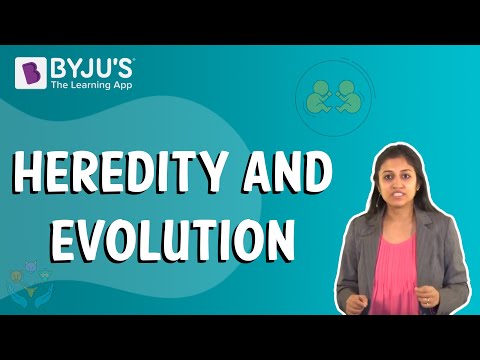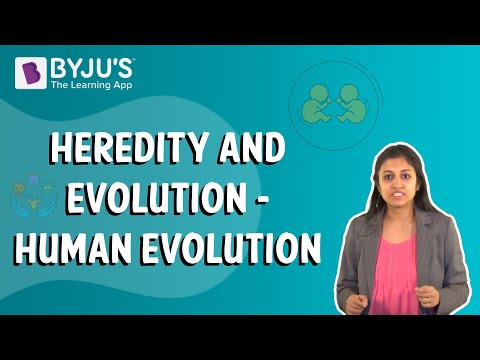According to the CBSE Syllabus 2023-24, this chapter has been renumbered as Chapter 6.
What Is Evolution?
Evolution is the study of the different forms of life, its characteristics and the changes over several generations. It is the scientific theory used by biologists to study the genetic variation in a population.
There are many theories about how life originated on the planet Earth. The theory of evolution is based on the idea that all species are correlated and progressively vary with time.
See Also: Important Questions for Class 12 Chapter 7: Evolution
For more information on Heredity and Evolution, watch the below videos


Darwin’s Theory of Evolution
Charles Robert Darwin, an English naturalist, geologist, and biologist, is well known for his theory of evolution and the process of natural selection. He gave the theory of evolution, which is known as ‘Darwin’s theory of natural selection’, and also published a book on “Origin of Species by Natural Selection”.
The main features of Darwin’s Theory are as follows,
- All organisms reproduce and multiply enormously.
- No two individuals are alike. They are different from each other either in size, shape, behaviour, etc.
- Some traits are consistently passed on from their parent to the offspring.
- The rate of reproduction varies in all living species. Some reproduce more and some minimum.
A Brief Account of Evolution
According to several theories of evolution:
- The first cellular forms of life appeared on Earth about 2000 million years ago.
- Later single-celled organisms, multicellular forms, and invertebrates were formed and became active.
- Jawless fish evolved, and different organisms started to invade from water to land. Later, amphibians and reptiles, some of them viviparous mammals, came into existence.
- About 23.03 to 5.333 million years ago, evolved primates that resembled today’s gorillas and chimpanzees. During the ice age between 75,000-10,000 years ago, modern Homo sapiens arose.
Evidence for Evolution
- It indicates the paleontological evidence, which denotes that life forms have arisen at various instances in the Earth’s history, which covers fossils, rocks from sediments, etc.
- Ernst Heckel proposed embryological support for evidence which was based upon the observation of some traits during the embryonic stages that persisted in all vertebrates that are not found in adults.
- The proposal was disapproved by Karl Ernst von Baer as he noted that embryos do not go through the adult phases of other animals.
- Divergent evolution is used to refer to the animals having the same structure developed along different directions as a result of adaptations to different needs. The structures are referred to as homologous, where homology represents common ancestry. Example – The tendrils and thorns of Cucurbita and Bougainvillea indicate homology.
- Convergent evolution refers to different structures evolving for the same function, thereby having similarities. This is why analogous structures are a result of convergent evolution. Examples of analogy – Flippers of Dolphins and Penguins.
- It was indicated that entities in a mixed population could adapt better, survive and cause an increase in the size of the population. But none of the variants got wiped out completely.
- Examples of evolution by anthropogenic action are the appearance of resistant cells/entities in a time span of months or years as opposed to centuries.
- Through this evidence, it was also indicated that evolution is not a directed process in the context of determinism; rather is a stochastic process basis the chance events in nature and chance mutations in entities.
Adaptive Radiation
- It is referred to the process of evolution of various species in particular geographical regions right from the point and radiating literally to other geographical areas. Examples are Australian marsupials and Darwin’s finches.
- Entities are better adapted to survive in an otherwise hostile environment as the adaptive ability is inherited, it being a genetic basis, whereas fitness is the outcome of the ability to adapt and hence getting selected by nature.
- Two key concepts of the Darwinian theory of evolution are branching descent and natural selection.
Hardy-Weinberg Principle
- This principle states that allele frequencies in a population are stable and are constant from generation to generation; the gene pool remains constant. This is referred to as genetic equilibrium, where the sum total of all allelic frequencies is 1.
- In a diploid, let p and q represent the frequency of alleles A and a. The probability that an allele A with a frequency of p appears on both the chromosomes of a diploid individual is simply the product of the probabilities.
- Five factors affecting the Hardy-Weinberg principle are – gene flow, genetic drift, genetic recombination, mutation and natural selection
- When the original drifted population becomes founders, the effect is known as the founder effect.
For more information on Evolution, watch the below videos


Few Important Questions
- Write a brief account of Evolution.
- List out the 5 mechanisms of evolution.
- What is Charles Darwin’s theory of evolution?
- What is adaptive radiation? Explain with examples.
Learn more about evolution and its theories from the topics given below:
| Endangered Species | Origin of Life |
| Evidence of Evolution | Evolution of Life on Earth |
Frequently Asked Questions on CBSE Class 12 Biology Notes Evolution
What is adaptive radiation?
Adaptive radiation is a rapid increase in the number of species with a common ancestor.
What is meant by genetic drift?
Genetic drift refers to random fluctuations in the frequencies of alleles from generation to generation due to chance events.
What is an ‘allele’?
An allele is one of two or more versions of a gene.
Comments